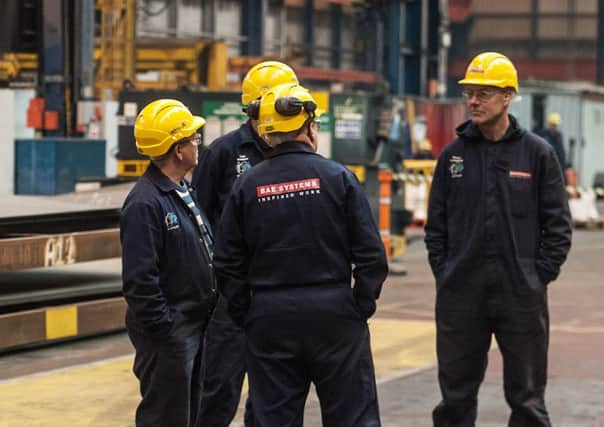Work to begin on second Type 26 frigate at BAE yard in Govan


The first piece of steel will be cut for the future HMS Cardiff at a ceremony in mid-August – an event that will allow the firm to showcase how it is delivering on a contract with the Ministry of Defence (MoD) worth £3.7 billion.
The first of the planned Type 26s, HMS Glasgow, is already well under construction at the historic Govan yard, with 25 of its 57 component parts assembled. Once the warship is floated out in around two years’ time, it will be finished at the BAE facility downstream at Scotstoun.
Advertisement
Hide AdAdvertisement
Hide AdHMS Glasgow is due to be handed over to the Royal Navy by “the mid-2020s”, by which time the wider Type 26 project will be well advanced.
The Scotsman was the only Scottish newspaper invited to the Clydeside yard yesterday for a progress report on the new frigate, which BAE call a “global combat ship”.
With a contract to build three Type 26s in Glasgow already in place, initial talks have now begun between the company and the MoD on a deal to construct a further five, which, once secured, would guarantee shipbuilding work on the Clyde well into the 2030s.
“We will enter into the negotiation phase in the next 18 to 20 months,” said Nadia Savage, director of the Type 26 programme. “As we progress through the maturity of the design, it allows us to commit to the next batch and the timeframe around them.”
Asked if the company had a contingency plan for any possible delays in securing the second batch of Type 26s, given the degree of political uncertainty in the UK, Ms Savage said: “The political situation will play out. We can’t control that, but what we can control is that entry into service. We understand what the navy’s requirements are and we can work back from that and engage with stakeholders when we need to.”
As a sign of its confidence the deal for batch two will be signed, BAE bosses point to the 2015 Strategic Defence and Security Review (SDSR), in which the UK Government committed to delivering eight advanced anti-submarine warfare ships for the Navy.
The Australian and Canadian navies will both build modified versions of the Type 26, which will be constructed overseas, but draw on BAE and its suppliers’ expertise in the UK.
In all, 32 vessels will be built around the world.
‘£100m investment’ in Clydeside shipyards
BAE has pumped £100m of investment into its shipyards at Govan and Scotstoun to prepare them for the construction of the first Type 26 frigates, the firm said yesterday.
Advertisement
Hide AdAdvertisement
Hide AdThe defence giant described the new global combat warship as the “core” of its naval ships division, which employs more than 3,000 staff on the Clyde alone.
Work is underway to build the first Type 26, HMS Glasgow, with construction set to start on the second, HMS Cardiff, next month at a ceremonial steel cutting event.
The third Type 26, HMS Belfast, will enter construction early in the 2020s.
It means shipbuilding is secure at the historic Govan yard, which dates back to 1864 when it was opened as the Fairfield Shipbuilding and Engineering Company.
By 1913, it was the largest and most advanced yard on the Clyde - the river where 20 per cent of the world’s ships were being built.
Fairfields was amalgamated in 1968 with four other Clyde yards and survived many brushes with closure before being nationalised in 1977. It was subsequently sold to the Norwegian Kvaerner group in 1988.
BAE Systems took control in 1999 and eventually published provisional plans to focus its operations on Scotstoun, which could have the seen the Govan yard close.
The company announced in 2015 that would retain its two Clyde yards to offer it maximum flexibility when building complex warships like the Type 26.